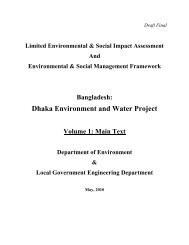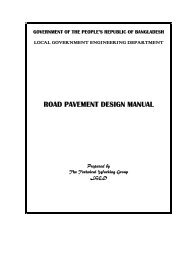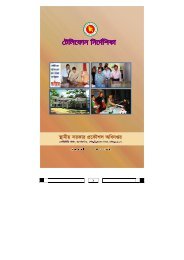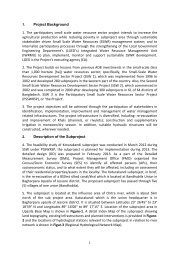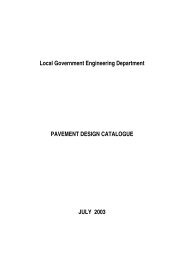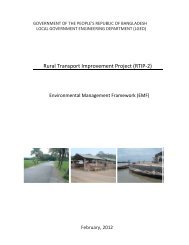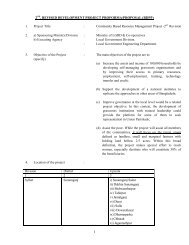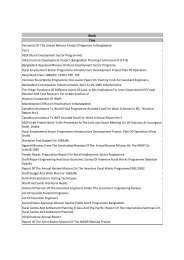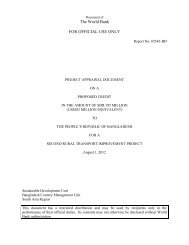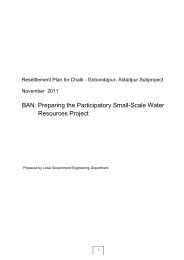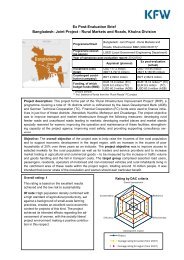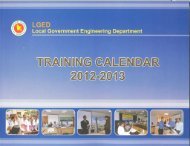environmental impact management framework (eimf) - LGED
environmental impact management framework (eimf) - LGED
environmental impact management framework (eimf) - LGED
You also want an ePaper? Increase the reach of your titles
YUMPU automatically turns print PDFs into web optimized ePapers that Google loves.
5. Environmental Categories. ECR 97 classifies projects by potential <strong>environmental</strong> <strong>impact</strong><br />
and assign different assessment and <strong>management</strong> requirements as follows:<br />
Green List projects are those with positive <strong>environmental</strong> <strong>impact</strong>s or negligible negative<br />
<strong>impact</strong>s such as plantation and nursery. Clearance for these is obtained on the basis of<br />
project description, initial screening and No Objection Certificate (NOC) by the local<br />
authority.<br />
Orange List projects fall into two categories.<br />
Orange A projects are those with minor and mostly temporary <strong>environmental</strong> <strong>impact</strong>s for<br />
which there are standard mitigation measures, such as the installation of tube wells, pond<br />
sand filter (PSF), tank/reservoir, sanitary latrines etc. Application for DOE’s<br />
<strong>environmental</strong> clearance requires general information, a feasibility report, a process flow<br />
diagram and schematic diagrams of facilities, <strong>environmental</strong> screening form, NOC from<br />
local authority.<br />
Orange B projects are those with moderately significant <strong>environmental</strong> <strong>impact</strong>s for which<br />
mitigation measures are easily identified, such as construction/re-construction of earthen<br />
roads, culverts, community center, office building for general services, re-excavation of<br />
canal, repairing embankment, and school field, etc. These require Environmental<br />
Clearance Certificate from DOE, for which an Initial Environmental Examination (IEE)<br />
report, Environmental Management Plan, along with the information and papers specified<br />
for Category A projects.<br />
Red List projects are those which may cause ‘significant adverse’ <strong>environmental</strong> <strong>impact</strong>s<br />
such as the construction of bridge, industrial factories, flood shelter, embankment, water<br />
control structure, etc. They require IEE report to obtain the Site Clearance Certificate,<br />
and subsequently a full EIA report for ECC, along with the information required for other<br />
Categories.<br />
6. Environmental standards also promulgated under the Environment Conservation Rules<br />
1997 are prescribed for varying water sources, ambient air, noise, odor, industrial effluent and<br />
emission discharges, vehicular emission, etc. with the main aim of limiting the volume and<br />
concentrations of pollution discharged into the environment. A number of surrogate pollution<br />
parameters like Biochemical Oxygen Demand, or Chemical Oxygen Demand; Total Suspended<br />
Solids, etc. are specified in terms of concentration and/or total allowable quality discharged in<br />
case of waste water and solid waste. Additionally specific parameters are specified such as<br />
phenol, cyanide, copper, zinc, chromium, various types of particulate, sulfur dioxide, nitrogen<br />
oxides, volatile organic compounds and other substances.<br />
7. World Bank’s Environmental Safeguard Policy. The Bank requires <strong>environmental</strong><br />
assessment (EA) and Social Assessment of projects proposed for Bank financing to help ensure<br />
that they are both socially and <strong>environmental</strong>ly sound and sustainable, and thus to improve<br />
decision making. The World Bank's <strong>environmental</strong> assessment policy and recommended<br />
6



